Dynamic Image Analysis (DIA) has been adopted in geotechnical engineering research to provide statistical descriptions of the particle size and shape of millions of individual sand grains. DIA provides accurate statistics of particle shape by capturing the 2D projected area of a large population of particles, at a random orientation. DIA can be divided into two methods: Two-dimensional (2D) DIA and Three-dimensional (3D) DIA. 3D DIA tracks the movement of individual particles falling in the image plane and captures particle images from 8–12 perspectives of selected particles. The resulting particle size and shape descriptors are calculated using average, maximum, or minimum values from all perspectives of each particle. In particular, 3D DIA can provide three-axis dimensions of a particle, which are closer to the actual particle morphology. Both 2D and 3D methods are fast, convenient, and computationally inexpensive, and the image dataset can be used for analyzing particle size and shape distribution, solving sand classification problems, and inferring sediment source tracing information. DIA can generate particle size distribution using Feret and EQPC diameters, and provide particle shape descriptors, including Aspect Ratio, Convexity, Sphericity, and Roundness.
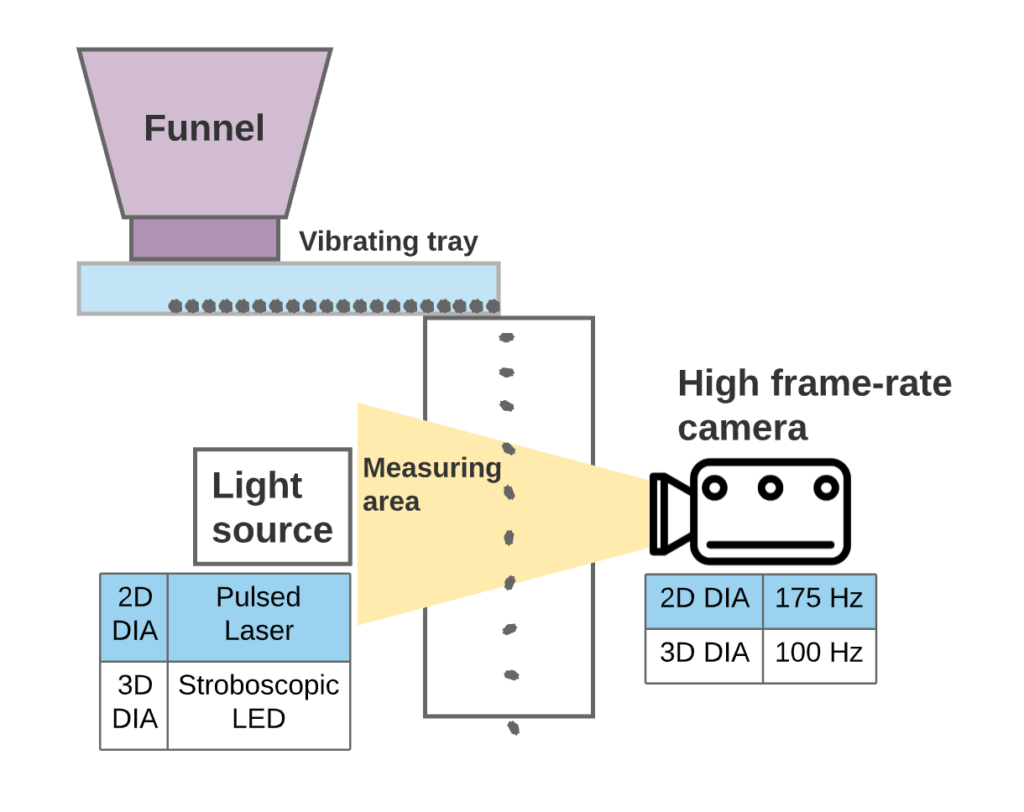
2D and 3D DIA typical images
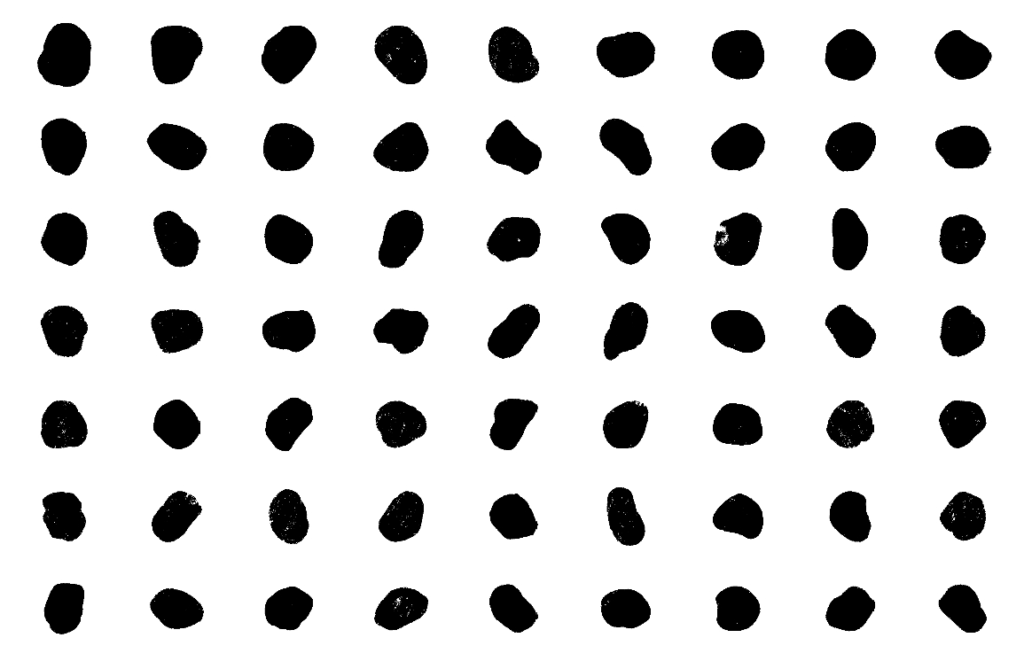

2D and 3D size and shape descriptors
In the past, 2D and 3D size, and shape descriptors were employed to quantify particle morphology. The primary work dates to Wentworth (1923), Zingg 1935 and Krumbein (1941) who used sphericity (3D) to quantify the bulk form of a particle. Sphericity is widely used today because it describes the elongation and flatness of a particle. Roundness (2D) which was also first distinguished by Wadell (1932), is a good indicator for particle angularity which measures the sharpness of particle corners. Initially, roundness was defined using two-dimensional projection of particles because 3D particle volume was difficult to obtain manually in the early years. Today, computational geometry can be used to compute particle volume, but the process is mathematically intensive for large particle sets, requiring the use of High-Performance Computing (HPC).
In general, shape descriptors compare the shape of a sand particle to a perfect circle or sphere. The numerical value of shape descriptors ranges from 0.0 to 1.0, where a symmetrical particle, such as a sphere, approaches 1.0, while a highly irregular particle has descriptors approaching, but never reaching 0.


2D and 3D DIA Measurement
2D DIA captures binary images of the particles as they free fall in the imaging frame. Although 2D DIA is practical for statistical size and shape analysis, there is a prevailing perception that it fails to fully quantify particle granulometry. In 3D DIA the system tracks a particle as it falls through the imaging frame and captures gray-scale images from 8-12 perspectives of the same particle, and the results are analyzed using average values of these 2D images. Although 2D and 3D devices employ similar methodologies they differ in resolution, frame rate, lighting systems, and algorithms.

- Particle size ranges from 4µm – 1cm for 2D DIA and 22µm – 3.5cm for 3D DIA
- Accurate particle shape measurement when particle size larger than 40µm for 2D DIA and 150µm for 3D DIA
- The individual particle image resolution of 4µm/pixel and 15µm/pixel for 2D and 3D DIA
- 2D DIA requires 10 times the number of particles to achieve the same mean shape values compared to 3D DIA
- In our experience 2000 particles are sufficient to capture mean shape parameters using either method
- Particle size characterization is generally independent of the machines and algorithms
- 3D DIA provides maximum and minimum particle axes which are closer to the real sand particle sizes
- Image-based particle shape characterization depends on particle angularity, image quality, and a hierarchy of shape descriptors, which results in numerical differences in the value of the shape descriptors obtained using 2D and 3D DIA methods. The numerical values are also influenced by preprocessing such as perimeter smoothing, thus results are to a degree machine and algorithm dependent
Comparison of 2D, 3D DIA and Micro-CT
2D DIA is gaining acceptance in geotechnical engineering research. Three-dimensional (3D) DIA extracts features from 8-12 projections of a particle thus it is believed to verge on the true particle morphology. DIA is fast, efficient, and convenient for characterizing thousands of particles quickly; nevertheless, it captures shapes that are fundamentally different than the 3D morphologies reconstructed using micro-computed tomography (µCT). In DIA particle features are interpreted using external images of a particle, which fail to account for differences in imaging perspectives. In addition, 2D and 3D shape descriptors are influenced by differences in dimensionality projection owing to variations in definition, dimensionality, and perspectives of the particle images employed which causes them to differ from their 3D counterparts.
Particles Captured by Micro-CT
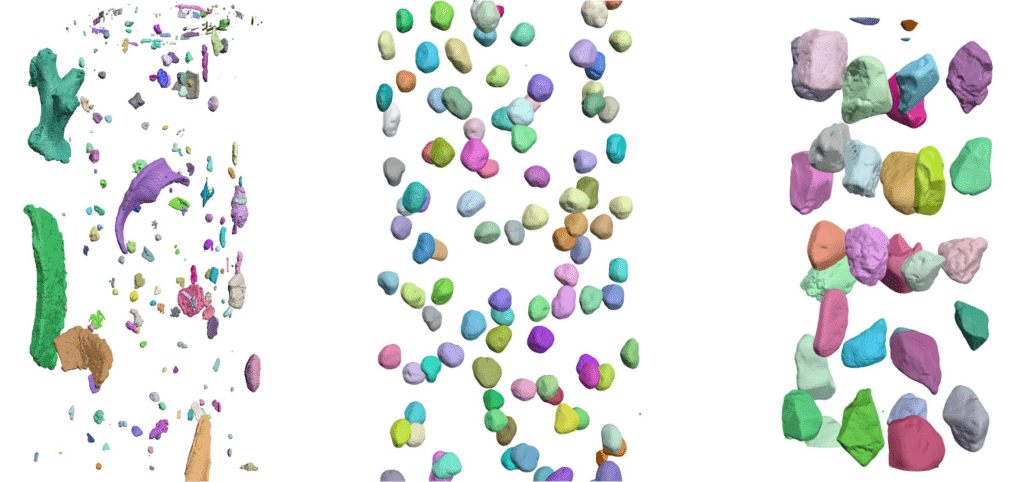
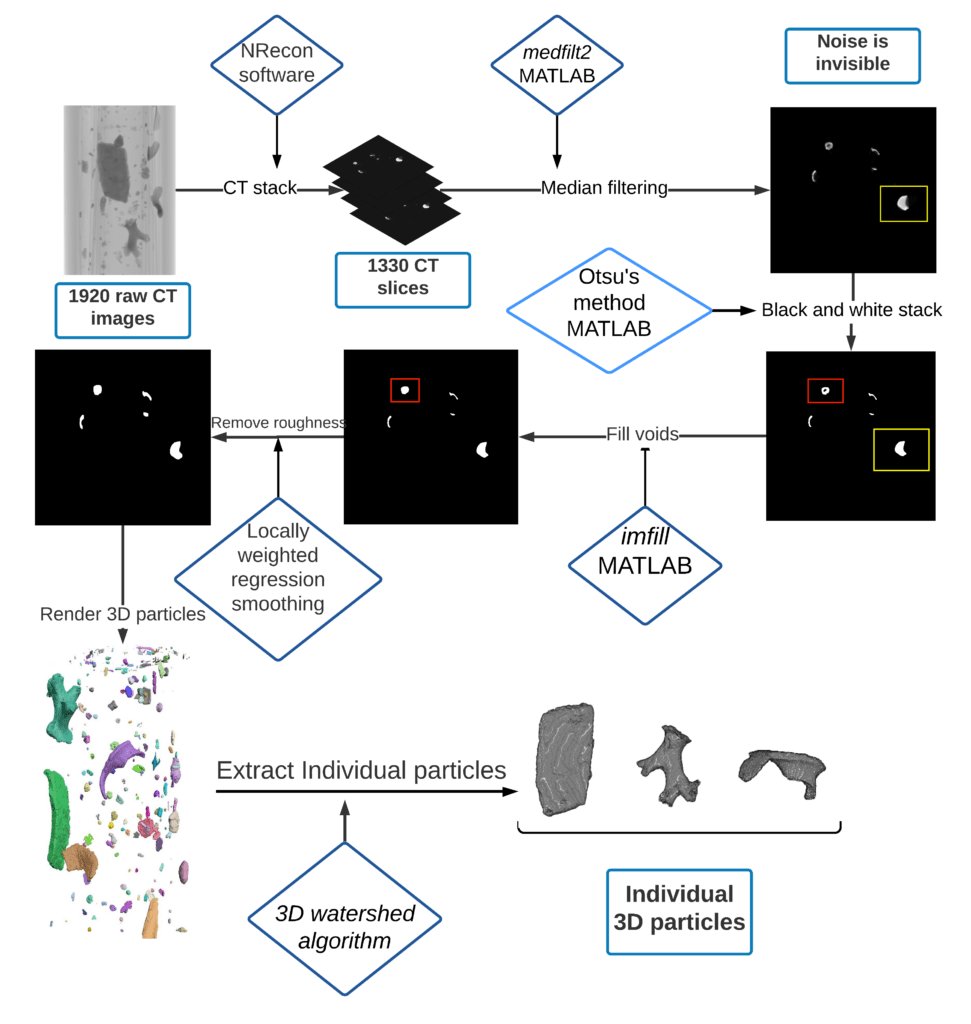
3D DIA and Micro-CT Measurement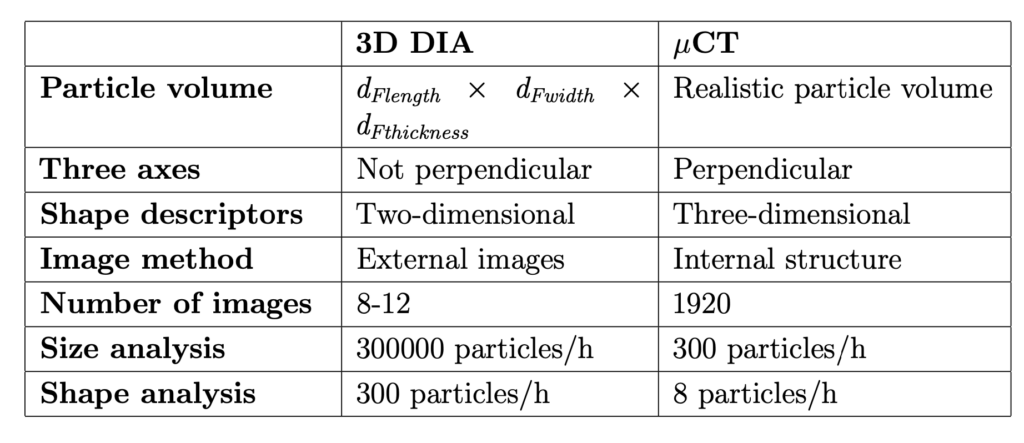
Accuracy of 3D DIA
- In general 3D DIA proved to be an efficient method for the characterization of regularly shaped particles, but less so for irregular particles
- 3D DIA measurement of PSD by assuming particles as cuboid calculated as dFlength x dFwidth x dFthickness are consistent with using real particle volumes, for regular shaped sands
- 3D DIA overestimates both the longest (dFlength) and shortest (dFthickness) axes of a particle
- 3D Roundness is difficult to characterize using DIA and shape measurements of complex irregular calcareous sands obtained from 3D DIA are not comparable to those obtained using µCT
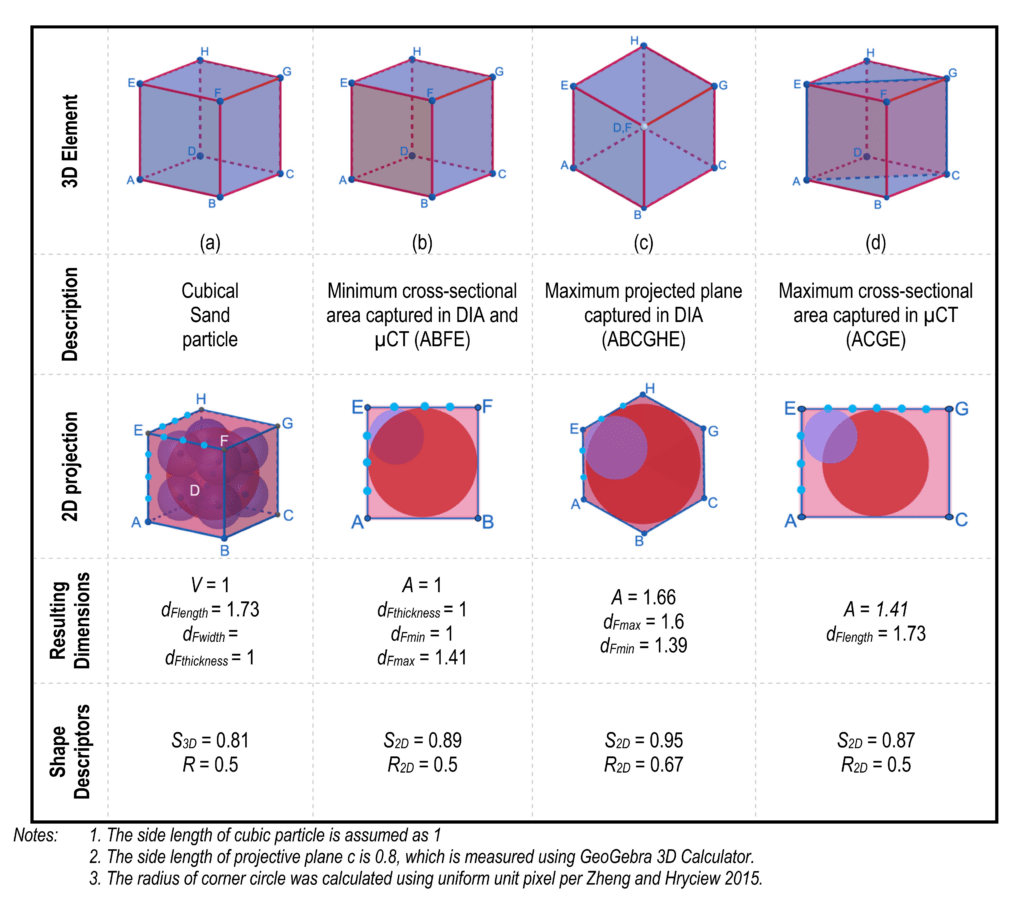
For the same particle, different shape descriptors could be captured by DIA and µCT
Particle granulometry methods
- How to choose the correct methods?
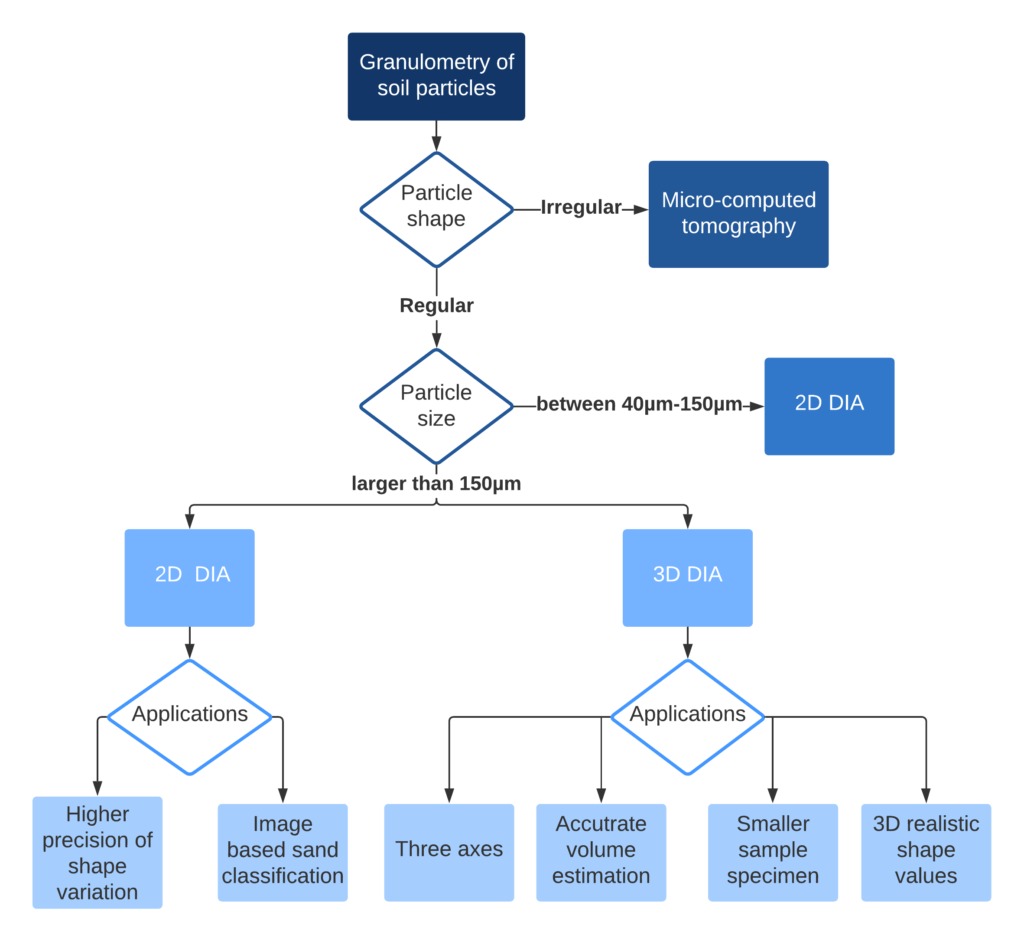
APPLICATION OF DIA FOR SAND CLASSIFICATION
Identifying sands is an important requirement in many geotechnical exploration projects. Knowledge of the sand type can help in estimating the physical and mechanical properties of a soil. Deep learning methods can be for automatically classifying sand types from individual images of sand particles. Dynamic Image Analysis (DIA) was employed to generate a large number of sand particle images, which were then used for training a deep learning model known as Convolutional Neural Networks (CNN). The analysis was based on 40,000 binary particle images for twenty types of sand. The work demonstrates that computer vision has a remarkable ability to automatically classify 64% of individual sand particles among 20 types of sand, the accuracy for sand clusters can reach up to 100% when a CNN model augmented with size and shape data is employed. While model training requires a lot of computational work, a pre-trained CNN model may potentially be tuned to run on mobile phones, which points to the potential for real-time field deployment to enable automatic soil classification on-site.



